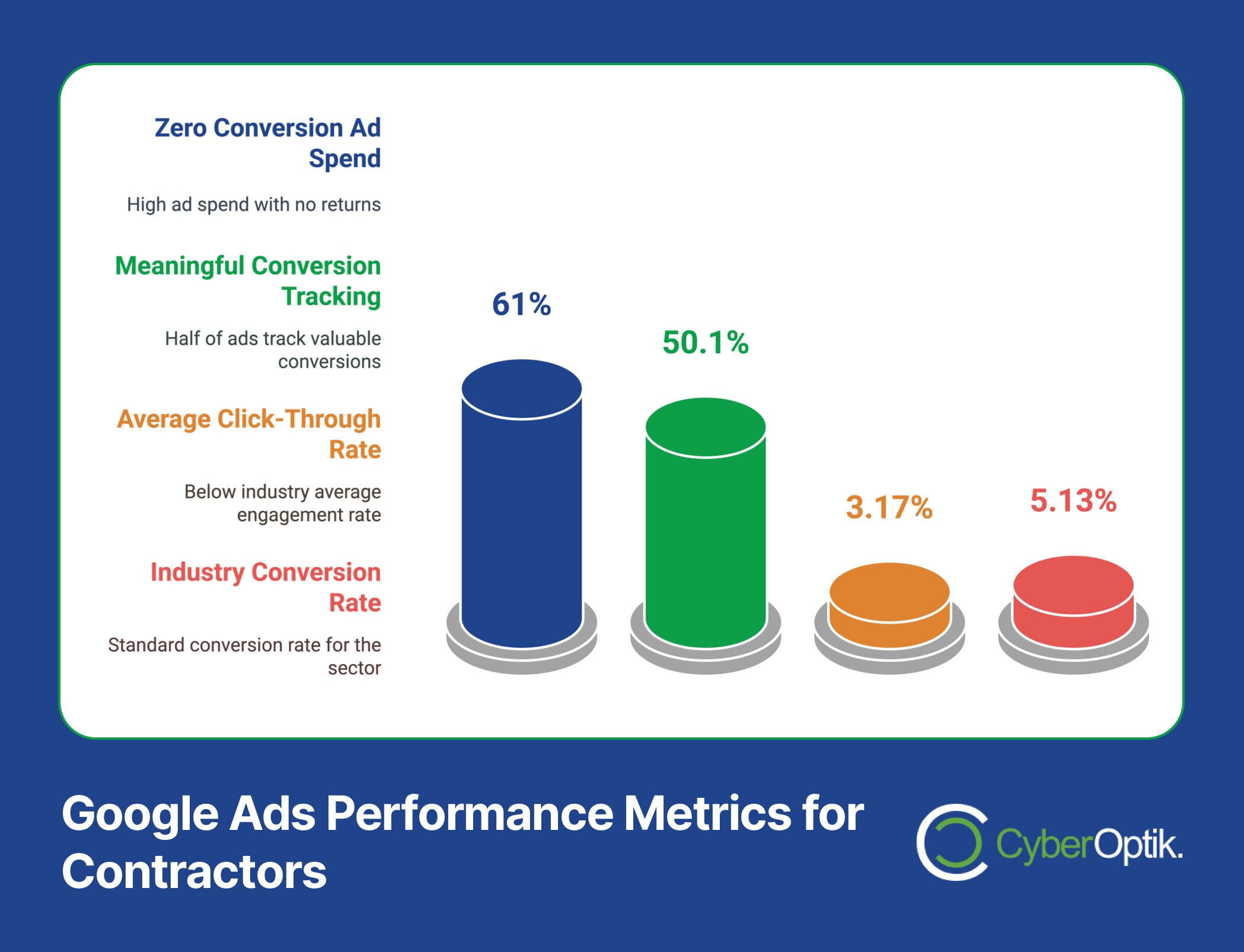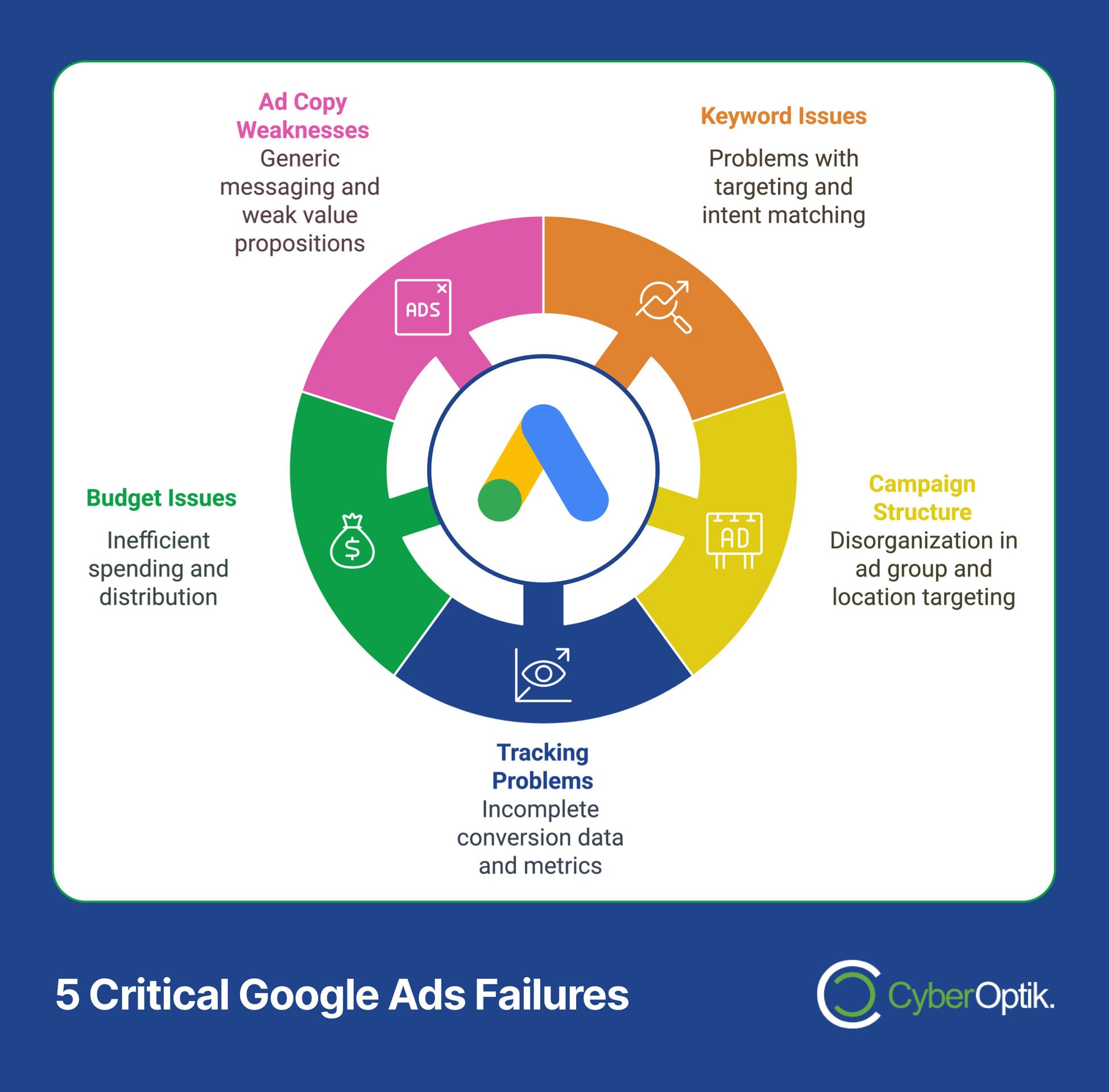Contractors waste millions of dollars annually on ineffective Google Ads campaigns. Our analysis of contractor advertising accounts reveals a startling truth: 61% of ad spend generates zero conversions (Source: Disruptive Advertising). We’ve witnessed this firsthand while working with construction companies, plumbers, and HVAC contractors across Chicago.

The problem isn’t Google Ads itself. The real issue lies in how contractors approach their campaigns. Through our work with hundreds of service businesses, we’ve identified the critical failures that drain advertising budgets and developed systematic solutions that transform struggling campaigns into lead-generating engines.
Our proven approach to google ads ab testing has helped contractors achieve consistent results, turning around failing campaigns and establishing sustainable growth. This guide shares our exact process for fixing the most common Google Ads mistakes that plague contractor campaigns.
Understanding these fundamental issues and their solutions will revolutionize your approach to Google Ads. Our systematic method addresses each failure point while building a foundation for sustainable advertising success. Here’s what you need to know about transforming your contractor Google Ads campaigns.
The Real Cost of Poor Google Ads Management
Poor Google Ads management creates a double-edged financial burden for contractors: wasted ad spend and missed revenue opportunities. Our audit findings show that only 50.1% of contractor accounts with tracking monitor meaningful conversions (Source: Disruptive Advertising). This fundamental tracking failure makes it impossible to measure true campaign performance or optimize for better results.
The financial impact extends far beyond visible ad spend. When we analyze ppc for contractors, we consistently find hidden costs that multiply the damage of poorly managed campaigns. Contractors often focus solely on their daily budget without considering the broader financial implications of ineffective advertising.
These hidden costs include lost market share to competitors, decreased brand visibility, and missed opportunities to capture high-value leads. While your competitors capitalize on strategic keyword targeting and proper conversion tracking, ineffective campaigns continue burning through budgets without generating meaningful returns.
Many contractors mistakenly believe their campaigns perform adequately because they receive occasional leads. However, this surface-level success masks deeper performance issues. Without proper tracking and optimization, these campaigns typically generate leads at 2-3 times the necessary cost, while missing opportunities to capture the most valuable potential customers.
The most significant hidden cost comes from misunderstanding the true value of properly qualified leads. High-quality leads from well-optimized Google Ads campaigns consistently show better conversion rates to paying customers. When campaigns fail to target effectively, contractors waste resources pursuing poorly qualified leads while missing opportunities to connect with their ideal customers.
Understanding these real costs provides the foundation for transformation. By identifying specific failure points in contractor Google Ads campaigns, we can implement targeted solutions that address both visible and hidden performance issues. The next section examines the five most critical failures that contribute to poor campaign performance.
Five Critical Google Ads Failures Contractors Face

Contractor Google Ads campaigns consistently underperform, with most achieving only a 3.17% click-through rate for search ads (Source: Pete Bowen).
Our extensive analysis reveals five fundamental failures that cause this poor performance, each compounding the others to create a cycle of inefficiency.
Poor Keyword Targeting and Research
Most contractors cast too wide a net with their keywords, targeting broad terms that attract unqualified traffic. While local service ads require precise targeting, many campaigns waste budget on loosely related search terms. This approach ignores the specific intent behind different types of searches, resulting in high costs for low-quality clicks.
Ineffective Campaign Structure
Campaign structure forms the foundation of Google Ads success, yet contractors often operate with disorganized accounts. We frequently discover campaigns mixing different services, locations, and audience types within single ad groups. This structural weakness makes it impossible to optimize bids effectively or deliver relevant ads to specific audience segments.
Inadequate Conversion Tracking
Without proper conversion tracking, contractors fly blind with their advertising investments. Many campaigns track only basic metrics like clicks and impressions while missing crucial data about lead quality, cost per acquisition, and return on ad spend. This lack of insight prevents meaningful optimization and leads to continued inefficiency.
Budget Misallocation
Successful Google Ads campaigns require strategic budget distribution across different services, locations, and times of day. Many contractors simply set a daily budget and hope for the best, missing opportunities to capitalize on peak performance periods or adjust spending based on seasonal demand fluctuations.
Weak Ad Copy and Messaging
Generic ad copy plagues contractor campaigns, failing to differentiate their services or speak to specific customer pain points. We see countless ads that focus on basic service descriptions rather than compelling value propositions. This weakness in messaging reduces click-through rates and attracts less qualified leads.
These five critical failures create a compound effect, each problem amplifying the others. Poor keyword targeting leads to irrelevant clicks, while weak tracking makes it impossible to identify and fix the issue. Meanwhile, ineffective campaign structure prevents proper optimization, and weak ad copy fails to convert the traffic you do receive. Understanding these interconnected problems provides the framework for implementing comprehensive solutions that address the root causes of poor performance.
The Data Behind Failed Campaigns
Construction companies achieve an average conversion rate of 5.13% in Google Ads campaigns (Source: Blue Corona). This benchmark provides a clear target for performance, yet many contractors struggle to reach even half this rate. Our analysis reveals the specific metrics that separate successful campaigns from failing ones.
Understanding your website conversion metrics becomes crucial when evaluating campaign performance. The data shows clear patterns in how failing campaigns deviate from industry standards across key performance indicators.
| Performance Metric | Industry Standard | Failing Campaigns |
|---|---|---|
| Quality Score | 7-10 | 3-5 |
| Click-Through Rate | 3.17%+ | < 1.5% |
| Conversion Rate | 5.13% | < 2% |
| Search Impression Share | 65%+ | < 40% |
These performance gaps directly impact campaign economics. Low quality scores increase cost per click, while poor click-through rates waste impressions on uninterested users. Combined with subpar conversion rates, these issues create a cascade of inefficiency that drains advertising budgets.
The relationship between these metrics reveals why many campaigns start strong but quickly deteriorate. Initial performance often masks underlying issues until the cumulative effect becomes apparent through rising costs and declining lead quality. Poor quality scores force higher bids to maintain position, while low conversion rates require more clicks to generate each lead.
Geographic targeting presents another crucial data point. Our analysis shows that failing campaigns typically target areas too broadly, diluting their budget across locations where they cannot effectively service customers. This approach not only wastes ad spend but also damages quality scores through irrelevant impressions and clicks.
Understanding these performance metrics provides the foundation for implementing effective solutions. By identifying specific areas where your campaign deviates from industry standards, we can prioritize improvements that will have the most significant impact on overall performance. The next section outlines our strategic approach to addressing these issues and transforming underperforming campaigns.
Strategic Solutions for Contractor Google Ads
Transforming failing Google Ads campaigns requires a systematic approach that addresses each critical failure point. While the typical Google Ads conversion rate hovers around 2.85% (Source: Search Engine Land), our strategic solutions consistently push contractor campaigns well above this benchmark.
Building Effective Campaign Architecture
Proper campaign architecture forms the foundation of successful Google Ads performance. Our approach begins with a complete restructuring of your account, creating dedicated campaigns for each service type and location. This granular organization enables precise budget control and targeted messaging that speaks directly to specific customer needs.
Strategic keyword organization plays a crucial role in campaign success, working hand in hand with your technical seo efforts. We segment keywords by intent, separating emergency service queries from maintenance requests and new installation searches. This separation allows for customized bidding strategies and ad copy that matches each type of search intent.
Implementing Proper Tracking Systems
Accurate conversion tracking provides the insights needed for continuous improvement. Our implementation process starts with defining meaningful conversion actions specific to your business. Phone calls, form submissions, and chat interactions each receive unique tracking parameters, enabling detailed analysis of lead sources and quality.
Optimizing Budget Allocation
Strategic budget allocation maximizes return on ad spend by focusing resources where they generate the best results. We analyze historical performance data to identify peak conversion periods and adjust bidding accordingly. This approach ensures your budget captures high-value opportunities while maintaining consistent lead flow during standard business hours.
Creating Converting Ad Copy
Effective ad copy drives qualified clicks by clearly communicating your unique value proposition. Our writing process focuses on highlighting specific benefits that matter to your target audience. Emergency response times, service guarantees, and financing options feature prominently in ads where these factors influence customer decisions.
The implementation process follows a systematic timeline, ensuring each element builds upon previous improvements. We begin with tracking implementation to establish baseline metrics, followed by campaign restructuring and keyword optimization. Ad copy testing starts once the foundation is solid, allowing for meaningful performance comparison.
- Week 1: Tracking Implementation and Baseline Analysis
- Week 2: Campaign Restructuring and Keyword Organization
- Week 3: Ad Copy Development and Testing
- Week 4: Budget Optimization and Performance Monitoring
This approach addresses both immediate performance issues and long-term sustainability. By implementing these solutions systematically, we create a foundation for continuous improvement and sustainable growth.
The next section provides a detailed implementation guide, showing exactly how to put these strategies into action for your specific situation.
Implementation Guide: From Failure to Success
Successful Google Ads transformation requires methodical execution. Our implementation process has helped contractors achieve click-through rates as high as 4.2% (Source: Organical SEO). This comprehensive guide breaks down the exact steps needed to turn around failing campaigns.
Phase 1: Comprehensive Audit and Tracking Setup
Every successful transformation begins with a thorough understanding of your current position. Our audit process examines historical performance data, identifying specific areas where your marketing strategy falls short. This initial analysis reveals quick wins while highlighting structural issues that require deeper intervention.
Proper conversion tracking setup follows immediately after the audit. We implement tracking for every meaningful customer interaction, including phone calls, form submissions, and chat conversations. This foundation of accurate data enables all subsequent optimization efforts.
Phase 2: Campaign Restructuring
Campaign restructuring creates the framework for sustainable performance improvement. We separate campaigns by service type, location, and customer intent. This clear structure enables precise budget control and targeted messaging that resonates with specific customer segments.
Keyword organization within the new structure focuses on intent matching. Emergency service keywords go into dedicated campaigns with appropriate budgets and ad schedules. Maintenance and installation keywords receive their own campaigns with messaging that addresses longer decision cycles.
Phase 3: Ad Copy Development and Testing
Effective ad copy development follows a systematic process of testing and refinement. We create multiple ad variations for each ad group, testing different value propositions and calls to action. Performance data guides continuous refinement, ensuring messages resonate with your target audience.
The testing process examines specific elements of ad copy effectiveness:
- Headline variations that capture attention
- Value propositions that differentiate your services
- Call-to-action phrases that drive conversions
- Extension combinations that maximize ad real estate
- Location-specific messaging that builds trust
Each element undergoes rigorous testing to identify the most effective combinations. We maintain detailed records of test results, building a knowledge base of what works for your specific market and services.
Phase 4: Budget Optimization
Strategic budget allocation ensures maximum return on your advertising investment. We analyze performance data to identify peak conversion periods and adjust bidding accordingly. This approach captures high-value opportunities while maintaining consistent lead flow throughout business hours.
Budget optimization includes careful attention to geographic targeting. We adjust bids based on performance data from different service areas, ensuring your budget focuses on locations that generate the best returns. This targeted approach prevents waste while maximizing visibility in your most profitable markets.
The implementation process typically spans 4-6 weeks, allowing time for data collection and performance validation at each stage. Regular performance reviews ensure the transformation stays on track, with adjustments made based on real-world results. This methodical approach builds a foundation for long-term success while delivering immediate performance improvements.
Measuring and Maintaining Success
Sustainable Google Ads success requires ongoing measurement and optimization. Top-performing contractor campaigns consistently achieve conversion rates of 6.96% or higher (Source: Blue Corona). Our systematic approach to performance monitoring ensures your campaigns maintain peak effectiveness while identifying new opportunities for improvement.
Key Performance Indicators
Effective performance monitoring starts with tracking the right metrics. While many contractors focus solely on cost per click, our comprehensive approach examines the complete conversion funnel. This holistic view reveals opportunities for improvement that basic metrics might miss.
Strategic integration with your content marketing efforts amplifies campaign effectiveness. By monitoring both paid and organic performance, we identify synergies that boost overall marketing ROI.
Weekly Performance Review Process
Our weekly performance review process examines critical metrics that indicate campaign health and identifies opportunities for optimization. This systematic approach prevents small issues from becoming major problems while ensuring continuous improvement.
- Conversion rate by campaign and ad group
- Cost per conversion trends
- Quality score changes
- Geographic performance variations
- Search term effectiveness
Each review generates specific action items for improvement. We prioritize these optimizations based on potential impact and implementation effort, ensuring efficient use of resources while maximizing results.
Monthly Strategy Refinement
Monthly strategy sessions take a broader view of campaign performance, examining trends and planning future optimizations. These sessions focus on aligning advertising efforts with your business goals while adapting to market changes and seasonal variations.
Strategic refinements often include adjusting campaign targeting based on performance data, testing new ad formats, and expanding into promising service areas. This proactive approach keeps your campaigns ahead of competitors while maintaining efficient resource utilization.
Quarterly Performance Analysis
Quarterly reviews examine long-term trends and strategic alignment. These comprehensive analyses compare performance against industry benchmarks while identifying opportunities for expansion or optimization. The quarterly perspective reveals patterns that might not be visible in shorter time frames.
This layered approach to performance monitoring ensures both immediate optimization and long-term strategic improvement. Regular monitoring catches issues before they impact performance, while strategic reviews drive continuous improvement. The combination maintains peak campaign effectiveness while adapting to changing market conditions.
Success in Google Ads requires this ongoing commitment to measurement and optimization. The most common questions about maintaining campaign performance focus on specific aspects of this process. Our FAQ section addresses these questions, providing clear guidance for contractors managing their Google Ads campaigns.
Frequently Asked Questions About Contractor Google Ads
Our work with contractors has revealed common questions about Google Ads management and optimization. These answers address the most pressing concerns while providing practical guidance for improvement. Understanding these fundamentals helps build a foundation for successful campaign management.
How Long Does It Take to See Results from Google Ads?
Initial performance improvements typically appear within the first two weeks of implementing proper tracking and campaign structure. However, achieving optimal results through systematic conversion optimization requires 4-6 weeks of data collection and refinement. This timeline allows for proper testing and optimization of all campaign elements.
What Budget Do I Need for Effective Google Ads?
Effective contractor campaigns typically require a minimum monthly budget of $2,000 to $5,000 per service area. This investment level ensures sufficient data collection for optimization while maintaining consistent lead flow. The exact budget depends on your market competition, service types, and geographic coverage area.
How Do I Know if My Google Ads Are Working?
Campaign effectiveness measurement requires proper conversion tracking and regular performance analysis. Success indicators include consistent lead flow, improving conversion rates, and decreasing cost per acquisition. Regular performance reviews should examine these metrics alongside broader business goals.
Should I Run Ads for All My Services?
Strategic service selection often outperforms broad advertising coverage. Start with your most profitable services and those with the clearest return on investment. This focused approach allows for proper budget allocation and optimization before expanding to additional services.
How Can I Reduce My Cost Per Lead?
Cost per lead reduction requires a systematic approach to campaign optimization. Key strategies include improving quality scores through better ad relevance, refining keyword targeting to focus on high-intent searches, and optimizing landing pages for conversion. Regular testing and refinement drive continuous improvement in lead costs.
What Makes Contractor Ads Different from Other Industries?
Contractor advertising requires specific attention to geographic targeting, service-based keyword organization, and emergency versus planned service messaging. Success depends on properly structuring campaigns to address these unique aspects while maintaining efficient budget utilization.
How Often Should I Update My Ads?
Ad copy requires regular testing and updating to maintain peak performance. We recommend testing new ad variations monthly while maintaining top performers. Seasonal service changes and special promotions may require additional updates to remain relevant and competitive.
These answers provide a foundation for understanding Google Ads management, but successful implementation requires ongoing attention to detail and systematic optimization. The strategies outlined in this guide address both fundamental issues and advanced optimization techniques, enabling sustainable improvement in campaign performance.
Transform Your Contractor Google Ads Today
Successful Google Ads management for contractors requires a systematic approach to campaign optimization and maintenance. The strategies outlined in this guide address both fundamental issues and advanced techniques that drive sustainable performance improvement. By implementing these proven solutions, contractors can transform failing campaigns into reliable lead-generation engines.
Our comprehensive approach to digital marketing ensures your Google Ads campaigns work in harmony with your overall business goals. The combination of proper campaign structure, strategic optimization, and ongoing maintenance creates a foundation for consistent growth and improved return on advertising investment.
Key takeaways from our analysis include the importance of proper conversion tracking, strategic campaign structure, and systematic optimization. These elements work together to create campaigns that generate qualified leads while maintaining efficient budget utilization. Regular monitoring and adjustment ensure continued performance improvement over time.
Success in Google Ads requires both technical expertise and industry-specific knowledge. Our team specializes in helping contractors achieve and maintain peak campaign performance through systematic optimization and ongoing support. We invite you to schedule a consultation to discuss how these strategies can transform your Google Ads performance.
Contact us today to begin your Google Ads transformation. Our experienced team will analyze your current campaigns, identify specific opportunities for improvement, and create a customized plan for achieving your advertising goals.
Take the first step toward better Google Ads performance by reaching out now.




